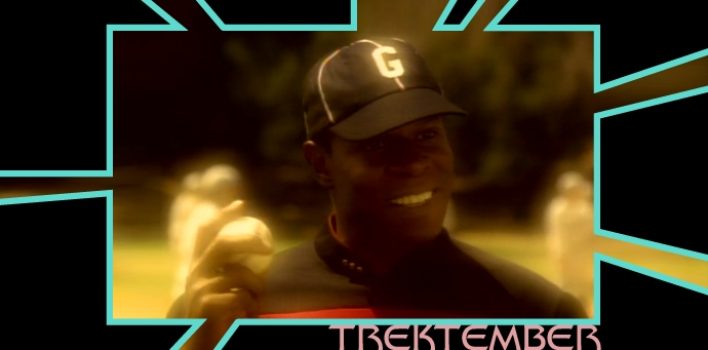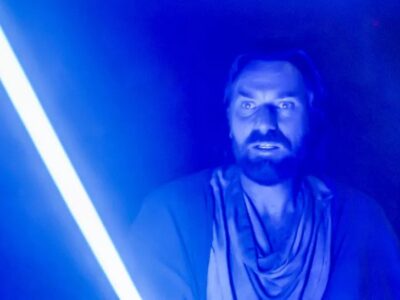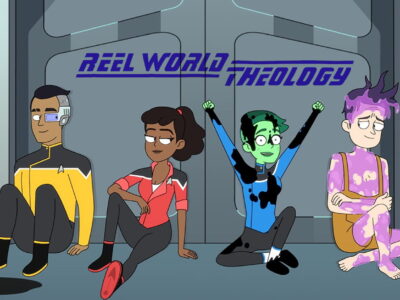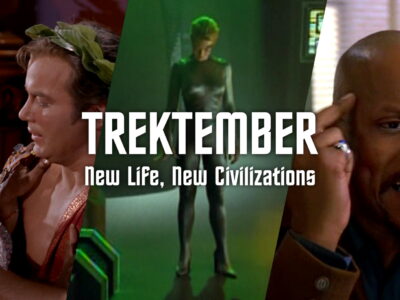Trektember: Emissary
Ah, Deep Space Nine. My favourite Star Trek series. Known at the time as the red-headed stepchild of the franchise, Deep Space Nine gave us long-form serialisation, character arcs with slow payoffs, some of the most memorable recurring guest stars, and our first look at a true interstellar war. In a lot of ways, it was a serious departure to what had previously been seen as the definition of Star Trek, and yet, in other ways, the essence of Trek was still very much at the heart of this show. Interestingly, we see this tension exemplified in our pilot episode, “Emissary.”
Deep Space Nine also gave us our first truly respectful exploration of faith and religion in the Star Trek universe. The original series see-sawed between implying that humanity had outgrown and abandoned all forms of religion, and acknowledging that “we find the one God quite sufficient.” The Next Generation’s approach was generally to portray religion as a dangerous thing best left behind as quickly as possible. Deep Space Nine gave us a major character with a spiritual belief; and while she wasn’t perfect, and sometimes wrestled with theological issues just as we do, it was generally seen as a positive influence in her life, and one that was deeply personal and important to her.
The show starts in an unexpected place, the battle of Wolf 359. Not only do we get to see some impressive battle sequences, which all happened off camera in The Next Generation, the episode also adds tremendous emotional significance to the event, as we see the personal effect it has on one family.
Benjamin Sisko is a fantastic protagonist from the first moment we see him. He has a dramatic character arc over the course of the episode, transforming him into the man he’ll need to be to carry this new show.
Deep Space Nine itself is rich setting, which is important since the majority of the show will be taking place there. The nearby planet of Bajor, with its breathtaking vistas, provides a useful contrast to the gritty abandoned space station. As we meet the characters, we quickly understand that, although they are mostly filling traditional Trek archetypes, they are also mould-breaking: Kira is irritable and doesn’t believe the Federation has any business being here. Odo is a gruff loner who cares nothing for Starfleet’s chain of command. Bashir is a bumbling academy graduate with eyes full of wonder, who manages to insult Kira the first time they speak to each other.
The inclusion of fan-favourite recurring guest star Colm Meaney (Chief O’Brien) as a regular character on the new show was brilliant move. We’d never had a family man (or woman) in the main cast before.
Likewise, Picard’s inclusion, which amounts to more than just a cameo, had my inner fanboy squealing (in a very masculine metaphorical fashion). I love that they had the boldness to immediately put the two lead characters at odds with each other, and for a logical reason. It amounted to some great drama, and a very satisfactory resolution when they finally shake hands at the end.
It is during an early conversation between Kira and Sisko that Bajor’s religion is first portrayed in a positive light. It gave their people strength and hope through a desperate time in their history. It held the Bajoran people together. It is a positive influence that can bring the warring factions together.
When Kai Opaka tasks Sisko with the quest of contacting the prophets, as an emissary between them and the Bajoran people, she tells him to “look for solutions from within.” Many religions teach this type of philosophy. The power is within us. This struck me as a contrast to the Bible’s teaching to look to God for our strength and our solutions.
Paul understood this.
But he said to me, “My grace is sufficient for you, for my power is made perfect in weakness.” Therefore I will boast all the more gladly about my weaknesses, so that Christ’s power may rest on me.
That is why, for Christ’s sake, I delight in weaknesses, in insults, in hardships, in persecutions, in difficulties. For when I am weak, then I am strong.
—2 Corinthians 12:9-10
And so did David.
I lift up my eyes to the mountains—
where does my help come from?
My help comes from the Lord,
the Maker of heaven and earth.
—Psalm 121:1-2
Dax was another character with an interesting edge. I don’t feel that “Emissary” did a great job of explaining what it meant to be a joined Trill. After my first watching of this episode so many years ago, I was a little confused. But later in the season, the episode “Dax” would explore this in great detail.
The discovery of the wormhole is the moment that changes everything. It explains why this particular story is one worth telling. Without the wormhole and the new frontier of the gamma quadrant, DS9 would just have been about Bajoran politics. The wormhole adds that classic Star Trek aspect of exploration. The CGI used for the wormhole itself was like nothing I’d seen before. It was very impressive for the time and still looks good today.
The section that follows as Sisko makes first contact with the prophets is as classic as Star Trek gets: a Starfleet captain communicating with, and trying to understand, a strange new alien race. One that is very different from us. At the same time, it manages to tie in thematically with Sisko’s arc and deliver and powerfully emotional conclusion to his journey.
The way the prophets exist in a non-linear time is a cool science fiction concept. It is one that is difficult to wrap one’s head around. It brings to mind the way that God exists in eternity, outside of our experience of linear time.
Sisko fulfils an important prophecy as he makes personal contact with Bajor’s gods. He speaks with them face to face. Until now, all they were their scriptures and perhaps the occasional orb encounter, but even that has been taken away as most of the orbs were stolen by the Cardassians. Sisko has opened the doorway between man and god. Can you imagine what a game-changer this was for the Bajoran people?
In the same way, when Jesus died on the cross, he became our emissary. He spanned that chasm between man and God, that we never could.
And when Jesus had cried out again in a loud voice, he gave up his spirit.
At that moment the curtain of the temple was torn in two from top to bottom. The earth shook, the rocks split and the tombs broke open. The bodies of many holy people who had died were raised to life. They came out of the tombs after Jesus’ resurrection and went into the holy city and appeared to many people.
When the centurion and those with him who were guarding Jesus saw the earthquake and all that had happened, they were terrified, and exclaimed, “Surely he was the Son of God!”
—Matthew 27:50-54
That curtain, torn from top to bottom, was so symbolic of what was happening. We don’t just have an emissary who met with God on our behalf. We have a God who become one of us and then died in our place to bring us home. It’s a simple truth. It’s the most fundamental tenet of our beliefs. But it’s also the most incredible thing to have ever happened. Let us never lose the wonder of it.
Meanwhile, back in the Alpha Quadrant, Deep Space Nine fends off an attack by a Cardassian captain looking for any excuse to resume hostilities. With only six torpedoes in the tube, Kira must bluff her way out in a way that feels a little reminiscent of Kirk. She shows so much grit in this scene. O’Brien says it best: “Major, remind me never to get into a game of Roladan Wild Draw with you.”
“Emissary” just scratches the surface of the awesomeness that would come in later seasons, but in my opinion, it was a very strong beginning, which nicely set the tone, and gave us the promise of good things to come.








Pingback: Trektember: Season 4 Episode List | Reel World Theology